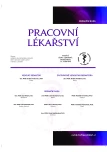Occupational diseases and risk categories – present trends in the Slovac Republic
Authors:
Ľ. Legáth
Authors‘ workplace:
Klinika pracovného lekárstva a klinickej toxikológie UPJŠ LF a UN LP prednosta prof. MUDr. Ľubomír Legáth, PhD.
Published in:
Pracov. Lék., 72, 2020, No. 1-2, s. 21-30.
Category:
Original Papers
Overview
The occurrence of reported occupational diseases belongs to the most important indicators of health care of the employees. Medical preventive examinations are among the most effective measures directed towards improving the health care of the employees performing occupations categorized in the high-risk third and fourth category. The work aimed to analyse reported occupational diseases in the Slovak Republic in workers classified in the risk-free first and second category and the high-risk third and fourth category. In the observed period from 2016 to 2019, more than 63% of diseases were reported in the category of risk-free work, which in 2019 represented 67.7% of all reported occupational diseases. The most frequent diseases were those related to repetitive strain injury of limbs with dominance in jobs classified in the second category with the diagnoses of carpal tunnel syndrome (88.5%), enthesopathy of the shoulder with the diagnosis of rotator cuff syndrome (72.9%), and elbow enthesopathy with the diagnosis of lateral and medial epicondylitis (72.1%). The most common cause of the reported occupational diseases were biomechanical factors, with 76.6% of diseases reported in workers classified in the second risk-free category; physical factors, with 81% of jobs classified in the third category; and biological factors, with 96.4% of jobs classified in the second risk-free category. Among biomechanical factors, repetitive work with unilateral movements prevailed, which was the cause of up to 98.3% of reported occupational diseases in workers included in the risk-free second category. According to NACE, the highest number of occupational diseases was reported in manufacturing in workers enrolled mostly in the second risk-free category, in production of motor vehicles, semitrailers and trailers, foodstuff production, production of leather and its products, and other kinds of production. In terms of the biological factors, occupational diseases were reported only in workers in the second risk-free category with diagnoses of scabies, morbilli, Lyme disease, tuberculosis, pertussis, and erysipeloid.
Keywords:
job categories – occupational diseases – international classification of diseases – NACE – Slovak Republic
Sources
1. Jarolímek, J., Legáth, Ľ., Urban, P. Occupational diseases in the automotive industry from medical and geographic viewpoints – comparison between the Czech Republic and the Slovak Republic. Central European Journal of Public Health, 2019, 27, 4, s. 296–304.
2. Ministerstvo zdravotníctva SR. Koncepcia zdravotnej starostlivosti v odbore klinické pracovné lekárstvo a klinická toxikológia. Vestník Ministerstva zdravotníctva Slovenskej republiky, č. 06332/2007 – OZSO, 8. októbra 2007.
3. Smernica Rady 89/391/EHS – opatrenia na zlepšenie ochrany a bezpečnosti pracovníkov pri práci. Dostupné na www: https://eur-lex.europa.eu/legal-content/SK/TXT.
4. Vyhláška MZ SR č. 448/2007 Z. z. o podrobnostiach o faktoroch práce a pracovného prostredia vo vzťahu ku kategorizácii prác z hľadiska zdravotných rizík a o náležitostiach návrhu na zaradenie prác do kategórií v znení neskorších predpisov.
5. Zákon č. 355/2007 Z.z. o ochrane, podpore a rozvoji verejného zdravia a o zmene a doplnení niektorých zákonov.
6. Zákon č. 460/1992, Ústava Slovenskej republiky.
Labels
Hygiene and epidemiology Hyperbaric medicine Occupational medicineArticle was published in
Occupational Medicine

2020 Issue 1-2
Most read in this issue
- Occupational diseases and risk categories – present trends in the Slovac Republic
- Manipulation technics as a prevention of the innjury risk and securing safe care
- Low back pain as a result of physical overload at workplace: a scoping review
- Budoucnost hygieny práce
